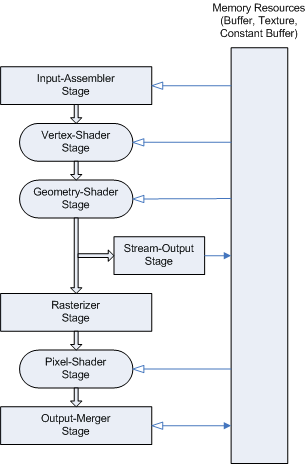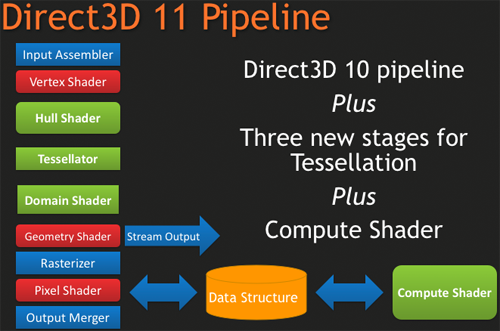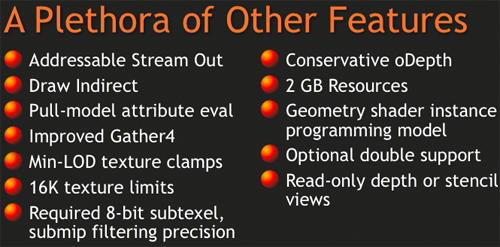Introducing DirectX 11: The Pipeline and Features
This is DirectX 10.

We all remember him from our G80 launch article back in the day when no one knew how much Vista would really suck. Some of the shortfalls of DirectX 10 have been in operating system support, driver support, time to market issues, and other unfortunate roadblocks that kept developers from making full use of all the cool new features and tools DirectX 10 brought.
Meet DirectX 11.

She's much cooler than her older brother, and way hotter too. Many under-the-hood enhancements mean higher performance for features available but less used under DX10. The major changes to the pipeline mark revolutionary steps in graphics hardware and software capabilities. Tessellation (made up of the hull shader, tessellator and domain shader) and the Compute Shader are major developments that could go far in assisting developers in closing the gap between reality and unreality. These features have gotten a lot of press already, but we feel the key to DirectX 11 adoption (and thus exploitation) is in some of the more subtle elements. But we'll get in to all that in due time.
Along with the pipeline changes, we see a whole host of new tweaks and adjustments. DirectX 11 is actually a strict superset of DirectX 10.1, meaning that all of those features are completely encapsulated in and unchanged by DirectX 11. This simple fact means that all DX11 hardware will include the changes required to be DX 10.1 compliant (which only AMD can claim at the moment). In addition to these tweaks, we also see these further extensions:

While changes in the pipeline allow developers to write programs to accomplish different types of tasks, these more subtle changes allow those programs to be more complex, higher quality, and/or higher performance. Beyond all this, Microsoft has also gone out of its way to help make parallel programming a little bit easier for game developers.










109 Comments
View All Comments
epyon96 - Sunday, February 1, 2009 - link
That's very insightful. Can you go into more detail?I am confused because there appeared to be significant differences between Dx9C and Dx9B since NVidia made it sound like the difference was like the difference between Dx8.1/2/3 and Dx8.4 which did seem very significant if memory serves me right.
The difference between 8.4 and 9 seemed minimal in quality of the final output.
GourdFreeMan - Monday, February 2, 2009 - link
The guidelines I spoke of were mentioned on the MSDN Forums circa 2003 regarding how changes to Direct3D would affect DirectX versioning, but seem to have been abandoned in favor of the bimonthly SDK updates following the DX 9.0c release. Bimonthly updates led to faster bug fixes, which in prior versions of DirectX sometimes required a letter update.If you are interested in the exact technical changes between DirectX versions, I suggest downloading the old SDK versions prior to the move to bimonthly updates and looking at the Changes section of the documentation.
Regarding the move between DirectX 8 and DirectX 9, Shader Model 2.0 was introduced making way for games such as Far Cry (admittedly Far Cry was a DX 9.0b game, but the changes from 9.0 to 9.0b mainly involved SM 2.0a and SM 2.0b which for Far Cry meant enhanced performance on ATi and nVIDIA cards). Far Cry would later be patched to support DX 9.0c and SM 3.0, adding features like HDR, but I would argue that the unpatched game still looked considerably better than DX8 titles.
(Incidentally there is no DirectX 8.3 and 8.4 -- there was 8.1a and 8.1b in the progression instead).
epyon96 - Saturday, January 31, 2009 - link
I wish the article had more background on what you just hypothesized (obviously with some substantiated facts) instead instead of the unnecessary vista bashing. It wound satisfy an actual curiosity.I remember that's one of the reasons why the in depth analysis of the development cycle of R770 was so well liked.
gamerk2 - Saturday, January 31, 2009 - link
The issue with DX11 is this: You need to supply a DX10 codepath for those who won't update GFX cards (you can't release a game no one has hardware for), but also would need a DX9 codepath for XP.Why would anyone release a game with three seperate grpahics code paths? Its for that reason I see a slow use of DX11, as long as XP holds 15-20% market share.
ltcommanderdata - Saturday, January 31, 2009 - link
If I remember those OS market share reports correctly, as of the end of last year Windows XP had about 65% market share, Vista has about 20% after 2 years, and Mac is nearing 10%. Even if Windows 7 is a roaring success, XP just has too much built-up market share to disappear overnight, so XP and DX9 compatibility will be required for at least another 2 years. The other thing that works against Windows 7 is that even if it isn't released until next year, it's introduction looks to be right in the middle of this economic recession, since things probably won't really pick up until late 2010 or 2011. When the economy does pick up again, there will be huge demand as companies finally switch from XP which would be 10 years old by then, but the first year of Windows 7 sales will probably be slow.bobvodka - Saturday, January 31, 2009 - link
Well, to be fair, you don't have to have a DX10 path and a DX11 path as such. A few important features work on DX10 cards anyway, such as the multi-threaded rendering stuff, so you need a DX11 and a DX9 path at most; you just have to do some feature detection to find out if you are on a DX11, DX10 or DX10.1 card.Still a slight pain, but not as much as 3 real code paths.
DarkMadMax - Saturday, January 31, 2009 - link
And main reason is consoles. There are practically no PC exclusives anymore among large budget titles (e.g. the ones who concentrate on graphics) . So all games target xbox360 hardware (if they dont they are ps3 exclusives). So until new generation of consoles appears there will be no progress in graphics. Periodhaukionkannel - Saturday, January 31, 2009 - link
To me, this article mostly talks about new features of DX11 and that some fundamental fealtures can benefit allso dx10 and dx10.1 hardware...To me it seems that the Vista part was only there to say why there are not any real DX10 games now, even the features are there. I didn't read it as an Vista hate like many people here seems to think of it.
All in all it was very good article abou how DX11 can allow those promises that DX10 promised to flourish better this time.
scruffypup - Saturday, January 31, 2009 - link
That though this article was supposed to be about DirectX 11, Derek's bias and opinion about Vista overshadowed the subject of the article,...This article shows poor writing at its finest,.. afterall doesn't writing 101 teach one to make the article about the subject you are writing about and not something else?
Again I say,... Derek does a disservice to anandtech with this bias. If you want to put in your bias towards an unrelated subject,.. at least show clearly the links (relevancy) to your intended subject material and how you come by a conclusion to support that claim other than just spouting off needlessly,... for that is what you have done essentially, as it held no relevance to the subject material the way you wrote the article.
chizow - Saturday, January 31, 2009 - link
Article summary:1)DX11 offers nothing new over DX10, as quoted in the article its just a strict superset that builds on and adds features to DX10 capability.
2)Vista and DX10 sucked because no one wanted to use them.
Derek, like many others I disagree with your assessment of Vista's importance in the overall OS hierarchy, here's just a quick list:
1) First OS to bring 64-bit support to the mainstream.
2) First OS to offer multi-threaded driver improvements. Look at Rel 180 and 8.12 Hot Fix, where multi-threaded drivers are all the rage.
3) First OS to offer DX10 support. We're finally seeing some of the performance benefits we were promised in DX10 with multi-threaded drivers and improved AA with reading of the multi-sample depth buffer.
4) Much better OS stability compared to XP. It wasn't always the case, but contrary to your article, most of the problems were fixed in July/August with the various video hot fixes (Ryan Smith can probably confirm or deny this).
I think Win7 just emphasizes how good Vista is, and how many light years ahead both are compared to XP. You could say Win7 is like Mojave SE, not Vista SE, as you can clearly see all the Vista-haters who are running Win7 glowing about all the features and stability they've missed out on for at least a year (since Vista SP1).